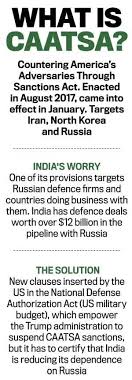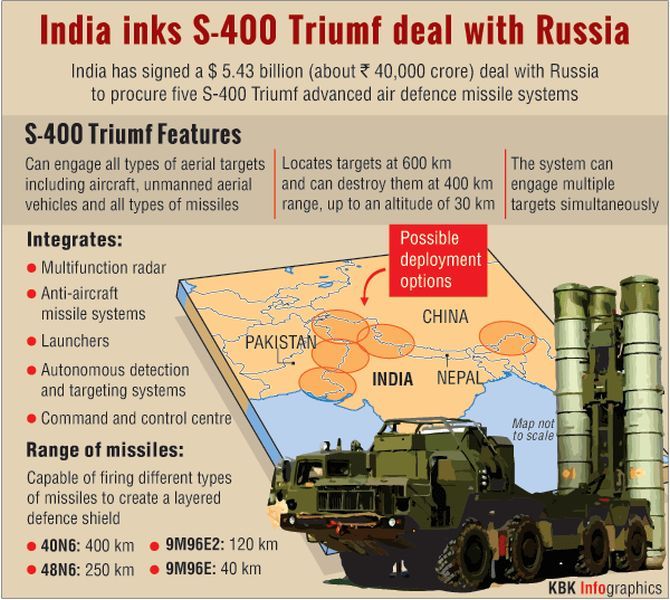S-400 purchase and CAATSA

Copyright infringement is not intended
Context: The United States Government has stated that the delivery of the five S-400 systems is considered a “significant transaction” under its Countering America’s Adversaries Through Sanctions Act (CAATSA) of 2017, which could trigger sanctions against Indian officials and the Government.
What kind of sanctions?
- The CAATSA is designed to ensure that no country is able to increase military engagement with Iran, North Korea and Russia without facing deterrent punitive action from the U.S.
- The sanctions are unilateral, and not part of any United Nations decision, and therefore no country is bound to accept them.
- Section 235 lists 12 options, including stopping credit lines from U.S. and international banks such as the IMF, blocking sales of licensed goods and technology, banning banks, manufacturers and suppliers, property transactions and even financial and visa sanctions on specific officials.
- The law empowers the President to waive sanctions or delay them if he/she certifies that the deal is not a threat to the U.S. and allies, that waiver of sanctions is in the U.S.’s “vital national security interests” or that the country being sanctioned promises to reduce its future dependence on the “adversary country”.
Has the U.S. used CAATSA before for S-400 sales?
- The U.S. has already placed sanctions on China and Turkey for purchase of the S-400.
Which way is the Biden administration leaning on India?
- The Biden administration had made it clear that the S-400 is “dangerous and not in anybody’s security interest”, but left the determination on sanctions after India takes delivery of the missiles to President Biden himself.
- Saudi Arabia has also reportedly negotiated with Russia for the S-400, and some experts in the U.S. feel that giving a waiver to India would be the wrong signal for others seeking to go ahead with similar deals.
What is India’s position?
- India has not backed down in the face of U.S. opposition and is scheduled to receive the first S-400 deliveries in December.
- India and Russia had protected the advance payments from triggering U.S. sanctions by ensuring a rupee-rouble transfer.
Why is the S-400 deal so important to India?
- S-400 is very important for India’s national security, especially as it faces new threats from China, Pakistan and Afghanistan, calling it a “game changer”.
- The system will also offset the air defence capability gaps due to the IAF’s dwindling fighter squadron strength.
- Integrating the S-400 into the national air defence architecture will be much easier as India has a large number of legacy Russian air defence systems, a major reason India did not consider the U.S. air defence systems as a viable alternative.
- For both political as well as operational reasons, the deal is at a point of no return.
- Buying the S-400 is a way for asserting India’s ‘strategic autonomy’.
What is S-400?
- S-400 (NATO name SA-21 Growler) is considered one of the world’s most advanced air defence systems that can simultaneously track and neutralise a range of incoming objects spanning aircraft, missiles and Unmanned Aerial Vehicles (UAVs) over very long ranges.
- It is especially suited to take down strategic aerial platforms like bombers, mid-air refuellers, reconnaissance aircraft and Advanced Early Warning and Control Systems (AWACS).
- Given their capabilities, the S-400 has emerged as one of the most controversial arms exports of Russia and a major point of contention between Washington and Moscow.

https://www.thehindu.com/news/national/explained-will-india-be-sanctioned-for-s-400-purchase/article37481472.ece



1.png)
